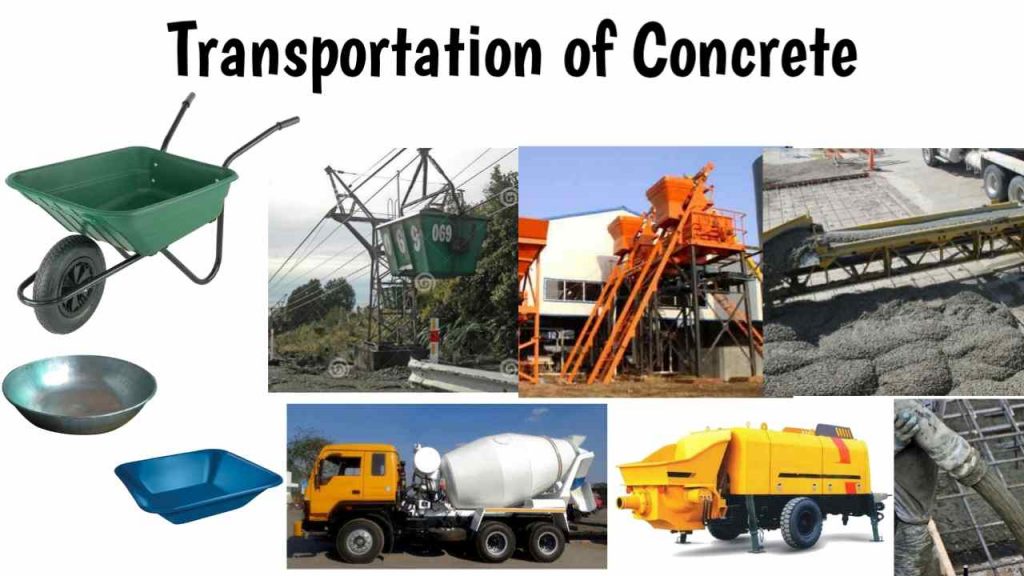In this article, we explain a Short Summary of Concrete production and placement which include various stages like batching of concrete, mixing of concrete, transportation of concrete, placing of concrete, compaction of concrete, and curing of concrete. so read the article till the end.
Table of Contents
Concrete Production and Placing Process:
Concrete Production and placing Process includes following stages that are given below.
- Batching of concrete
- Mixing of concrete
- Transportation of concrete
- Placing of concrete
- Compaction of concrete
- Curing of concrete
1. Batching of concrete:
Batching is the process of measuring of material required for concrete mix by weight or volume.
Batching is done by two approaches.
- Volume batching
- Weight batching

i. Volume batching:
Volume batching is done by a typical gauge box that is known as “farmas” in the field. The volume of farma is 0.035m3 which is similar to the volume of 1 bag of cement.
Farma is made of timber, steel or plastic materials.
ii. Weight batching:
Weight batching is done manually or semi-automatically, or fully automatically. Mostly it is used in Ready mix concrete plants.
This type of batching is mostly used for large construction.
2. Mixing of concrete:
Mixing is necessary to make homogeneous concrete. To obtain a good quality of concrete, it is necessary to do proper mixing of concrete ingredients. The mixing of concrete depends on the types of mixing.

Generally mixing is done by three ways.
- Hand mixing
- Machine mixing
- Ready-mix concrete
i. Hand Mixing:
In this way mixing of concrete done by the hands of workers. This type of mixing is used for small construction work due to high time consumption. Also the quality of the concrete we get very less.
ii. Machine Mixing:
In this way, the mixing of concrete done by various types of machinery. It is used for medium to large construction work for example 3 to 4 story building construction.
Three types of machineries used for mixing of concrete.
- Tilting type
- Non-tilting type
- Reversing type
iii. Ready mix concrete:
Now a day’s ready mix concrete become most popular for large construction because it gives high-quality concrete. Also, it gives the flexibility to do concreting work at the site where we can’t able to produce concrete like the valley, mountains region, etc.
In valley regions, concrete ingredients like cement, aggregate, sand, water, and other materials are not easy to available. So we need to transport material from other locations which increase the cost of construction.
In this type of mixing, concrete mixing is done in a ready mix concrete plant that is situated on-site or another site. In the case of the RMC plant situated in another place, the concrete can be transported by the transit mixer to the construction site.
It is economical for large construction.
Ready mix concrete plant Consist the following parts:
- Batcher (to measure material)
- Conveyor system (to move ingredients of concrete to the concrete mixer)
- Silos (to store cement)
- Concrete Mixer (To mix concrete)
- Screw Conveyor (to convey cement from silos to the concrete mixer)
- Etc,
3. Transportation of concrete:

There are various methods used to transport concrete. Few of its are given below.
Mortar pan:
A mortar pan is used for small construction work in which concrete or mortar can be transported by laborers using a mortar pan.
Wheel Borrow:
The wheel borrow method of concrete transportation is suitable for long-distance concrete transportation on the site. It is majorly used for the construction of roads, slabs, etc.
Bucket & Ropeway:
Bucket & ropeway method of concrete transportation is used to transport concrete in valley areas.
Transit mixer:
A transit mixer is suitable for long-distance concrete transportation. It is used to transport a large volume of concrete to the construction site which is situated a long distance away from the mixing plant.
Skip & Hoist:
It is used in concreting of skyscraper building.
Pumps & pipelines:
Now a day’s this type of concrete transportation is most popular for concreting work in tall structures. In this method, concrete is transported through the pipes by using pumps. In this method, concrete conveys from a central discharge point to formwork.
Belt conveyors:
It is used to convey concrete horizontally or inclined on the construction site.
4. Placing of concrete:
Placing of concrete is the process of deposition of concrete in its required position.
Placing of concrete under water is done by various methods.
- Tremie method
- Bagged method
- Bottom dump method, etc.
5. Compaction of concrete:
Compaction of concrete is a process in which concrete is compacted by various methods to remove entrapped air from the concrete and increase the strength of concrete.
By doing compaction of concrete, concrete becomes dense, impermeable due to that the durability of concrete increases.

Compaction of concrete done by two ways.
- Hand compaction
- Mechanical compaction
i. Hand compaction:
Hand compaction of concrete is done by various techniques.
- Roding
- Ramming
- Tamping
ii. Mechanical compaction:
Mechanical compaction is done by various type of vibrating machineries which are given below.
- Needle vibrator
- Form vibrator
- Table vibrator
- Surface vibrator
6. Curing of concrete:
Curing of concrete is defined as a process to maintain temperature and moisture of concrete during the hydration process of cement due to that hydration of cement completed and concrete gains maximum strength.
Curing of concrete done by various methods that are given below.
- Water curing
- Membrane curing
- Steam curing
- Other techniques
we already explain all techniques of curing of concrete in another article, so please go and see.
Also Read: What is curing || Methods of Curing of Concrete || Explained

